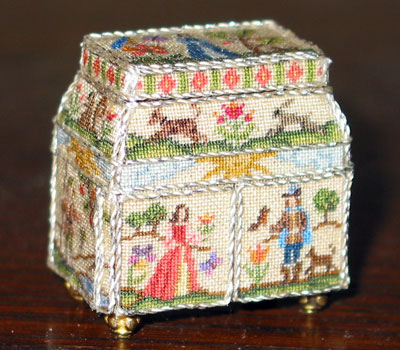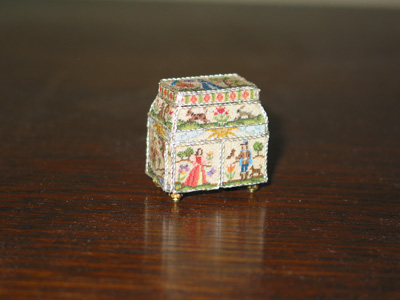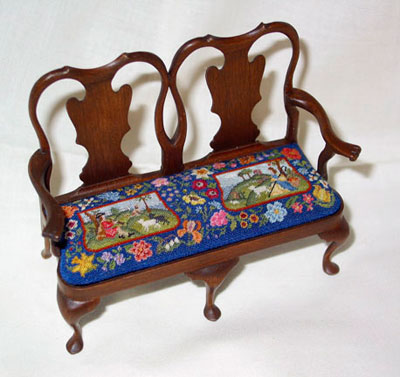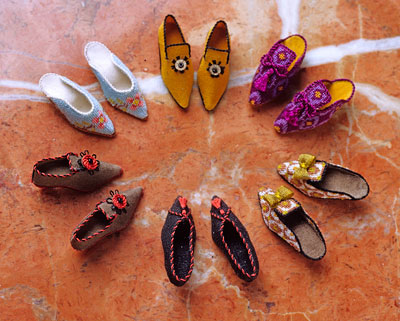Even though I’m officially back from vacation, I still have two more guest posts on needlework that I want to share with you. Both are really good – and they touch on needlework topics that I don’t often visit. This first one is by Patricia Richards, who operates Patricia Richards Miniatures, a website devoted to hand made dollhouse miniatures, as well as kits for miniature pillows. Patricia stitches incredibly tiny miniature items in unbelievable detail! She enticed me with the topic of her miniature embroidery projects by sending me a picture of her reproduction 17th century embroidered casket, which you can see in the article below. The casket is beautiful – full-size, it would be amazing in itself. When I realized the piece was about an inch wide, it took me a while to pick up my jaw! I hope you enjoy the article and are just as amazed as I am at the micro-stitched art!

How small can you go? That would depend on a couple of factors: How good are your eyes? And can you find materials fine enough to work with?
As far back as I can remember, I’ve always sewn and crafted, but after the gift of a dollhouse kit, I started working in 1/12 scale (that is 1” equals 1’), the scale most prevalent for dollhouses. In 2007 I was fortunate enough to find myself in a class taught by Annelle Ferguson in which we were to recreate, in 1/12 scale, a 17th century English Casket. We were each given a plain wooden casket, (made by artisan Mark Murphy), complete with 7 tiny functioning drawers and a lift-out tray beneath the lid. Annelle then guided us through the process of drafting patterns for each surface to be covered. To approximate the look of the full size caskets, it was necessary to work very fine, for us that was 72 stitches to the inch on silk gauze. Silk gauze is available in counts as high as 120 stitches to the inch, but it gets increasingly harder to find thread to stitch so fine. And it is increasingly harder to see.

1-1/8″ tall and 1-1/8″ wide.
To stitch on the 72 count, I found it necessary to use 5X magnifiers, the strongest I could find, that clipped onto my glasses. There are quite a few different styles of magnifiers, each available in a number of different strengths, to aid stitchers, and the best advice I could give would be to try a few and see what works for you and your project.
Once you can see to do the stitching, the issue of threads comes into play. On 72 count gauze, you need to work with a thread like a 100 weight silk, or its equivalent. YLI makes 100 weight silk thread in 64 colors, which sounds pretty good, until you start trying to match them to the vision in your head, it is not enough. Some stitchers use other weights and split the plies, but that is a little tricky and I didn’t enjoy it. My solution, was Pipers Silk floss, with more than 200 colors, I was in stitcher’s heaven.

The next year, I was again in a stitching class with Annelle. This time we were working the cover for a settee seat. For this project we were encouraged to work on 58 count gauze. When working on pieces that will be seen in a room setting, you need to work in different scales so that in the overall view, proportions will appear to be ‘correct’. The largest scale pieces should be the biggest pieces-like a carpet. As you work smaller pieces, the scale should also get smaller, saving the finest scale for the smallest pieces, like the casket. If all were worked in the same scale the rug would appear to be much finer than the accessories and the accessories could come off looking clumsy in comparison.
Another issue you may notice when you begin stitching in a smaller scale, is that colors don’t always ‘read’ the same. Color combinations which look perfect in your hand, don’t look the same when stitched in these tiny areas and you may find you need to rework portions of your design to compensate for that, sometimes more than once.

This week, I found myself with an enforced break in my current project and looking through my bookshelf, I found a photo of a bucolic 18th century needlework scene that I decided would make an excellent miniature project. Through the process of enlarging and tracing the picture to create a chart, I was again revisiting a sight issue; this time the necessity of letting your eyes and brain, fill in the details. Even though you are working in quite a fine scale, you will never be able to fit in all the detail you know is there. At the very least, facial details are impossible to work convincingly. If you can manage a dot for an eye, it will usually appear clumsily so it is quite acceptable to leave those details out. It will still ‘read’ as a human figure, or a sheep or a dog, without eyes, nose and mouth.
Working dollhouse scale miniatures on silk gauze has been an interesting and rewarding experience. If you have the yen, silk gauze is available from several sources on line. The classes I took from Annelle Ferguson were held under the aegis of the International Guild of Miniature Artisans at the Guild School held in Castine, Maine each June. The Guild is a wonderfully supportive organization that provides a number of learning experiences around the country. Another support system is the Petitpointers chat group on Yahoo where tips and work in progress is shared daily.
See what I mean by jaw-dropping?!
Ok, who’s up for some miniature embroidery? This really appeals to me! I’d love to make tiny cushions and even some of the little wallhangings that are shown on MicroStitchery. These miniature Cluny tapestries are calling my name!
Update, 2018: While MicroStitchery is still online, they are no longer honoring orders. I have heard from many folks who have placed orders with them, but have never received the orders and had to apply to PayPal for a refund. I’ve tried to contact Joy, the lady who took over the business, but with no luck. Just a word of caution, for those looking for miniature tapestries!
Patricia has two shows coming up. One is in September, in New Jersey at the International Guild of Miniature Artisans and the other is in November with Philadelphia Miniaturia, at their premier dollhouse miniature show. If you live in either area, you might want to check out the shows!
If you’re hankering to try something itty bitty in the way of embroidery, or if you want to outfit a fine miniature house, drop by Patricia’s website.
And, finally, if you have any resources for miniature embroidery supplies or if you want to leave a comment or ask any questions, please don’t hesitate using the comment form below!







That casket is beautiful. I’ve done a lot of what I call “micropoint” using silk gauze- both 1/12th scale and full size. My eyes won’t let me get finer than a 48 count, but I love the result. I used an 18 count cross stitch chart and 48 count silk gauze for my last piece. It ended up being 5″ x 7″ and looks like a painting. (Yes, that’s a lot of stitches but the results are worth it.) It’s worth noting that back stitches are impossible, so keep that in mind when choosing a chart to miniaturize.
I’m not sure I would want to do a miniature project even though I admire them often. I have worked on 40ct silk and that was enough! I envy those who work on smaller fabrics. Its beautiful! I will watch as you work on these projects!
Amazing work. I can’t believe Patricia has incorporated so many details into her miniatures. Wow! Thanks Mary and Patricia.
Oh my goodness! Incredible! I guess my new stitching/reading glasses would be pretty useless to do this kind of work. I love doing small designs and working on something so tiny does fascinate me. The delicacy of the work is just amazing! Thank you for sharing this with us Patricia and Mary!
Kathy
Wow, this casket is unbelievable. I cannot imagine all that work and only having a piece 1″ x 1″ when completed. I admire the patience it took to do it too. I would need to be committed !!!!
Wow, these miniatures are incredible! I do Japanese Embroidery, and the smaller something is the harder it is to make it look right.
I have a question – do you know a method to straighten bent needles? I found a method for straightening airbrush needles online, in which you put the needle between 2 quarters (coins), and press hard on the quarters while pulling and twisting the needle thru. Not sure if this would work for embroidery needles, though.
Thanks!
Christine
Oakton, Virginia
Hi, Christine –
Well, I’m not quite sure. I haven’t heard of the quarter method for straightening. Usually, if it’s a very fine needle, I try to warm it up a little bit, and then I lay it on a hard flat surface, and try rolling something hard and flat over it, back and forth. It doesn’t always work, but it’s the only thing I’ve ever really thought of doing. It actually works somewhat – it doesn’t get it back to “new” but it does straighten it a bit. I haven’t tried it with thicker needles. I think I was working with a #11 or 12 crewel…
Hope that helps!
MC
At a point in my life where I needed an excuse to NOT date, I purchased a dollhouse — and was then able to tell people “sorry, I have things to do around the house…”
Now, my dollhouse is still in a box out in the garage; the moving company packed it and broke so much of it that it sickened my heart. I’m not even sure if the electricity still works.
So … for a very long time I’ve been interested in miniatures. Even gave some thought to painting mini-Cezanne and other notables. I never got around to stitching a rug or pillows.
Mary, I’m so glad to have found you and others who share their passions.
Gentle as you go,
Marny
The jaw is still on the floor! Why is it that tiny, tiny work is so intriguing? I also wonder how the woodworker made such a small, working casket! Fun, fun article!
I have a Cluny-based mini pillow kit from that site…
…but what I want to know is whether it’s possible to buy casket kits somewhere. I WANT.
I have loved miniatures as long as I can remember. These are absolutely some of the most beautiful things I have ever seen! I can’t do such delicate work and admire those who can!
Hi Mary,
Welcome back…….
I absolutely love anything in miniature; my
daughter stitches on 32 count silk canvas and
is working on some 1″ Christmas stockings.
I’ve ordered kits from http://www.janetgranger.co.uk;
she has a fabulous selection of embroidery kits. Also, visit the Tom Bishop miniature shows; the one in Illinois is usually in April.
It’s probably the largest miniature show in the
midwest. Check his website for show dates.
Your stitched Casket is absolutely gorgeous.
Happy Stitching,
Teri
Wow! Amazing Work! I can’t get over all the detail.
Gorgeous miniatures! How small can I go? I’m not sure any more. In years past, I could just take off my glasses, and it was the same as using a magnifier for me. Since the need for bifocals has kicked in, my close vision is different in both eyes.
Besides the issue of finding small threads, how small of a needle is needed to work on the small items?
Hi, Gail – I think a #12 is recommended on the higher count silk gauze. It’s pretty tiny, and because the gauze is more like a canvas than a fabric, it fits in the holes…
wow! I think I’d go cross-eyed trying to stitch that!
Stunning work! I would love to try this.
Hello,
First of all, I’d like to say thank you for this great site and brava to Patricia Richards for her beautiful work. I am planning to begin creating miniature embroidered pieces to be mounted in jewelry (such as pendants,etc.) I will be doing crewelwork and not counted stitching. Does anyone have any recommendations for the best fabrics (i.e. materials & counts) to use and the best threads or flosses to use? I came across one site that mentioned one strand DMC cotton floss but didn’t mention the fabric. Since I won’t be using a counted stitching method, can I use any high thread count fabric? What about techniques for transferring patterns to the fabric? If anyone could answer those questions or point me to some resources that may be able to help, I would greatly appreciate it. Thanks in advance!
I would use a very fine batiste fabric and silk embroidery threads. DMC gets very fuzzy, and the silk glides through the small holes in the fabric better. Pipers silks or Hand-dyed fibers are two of my favorites, but there are many more if you search online. I would use either a #12 sharp or a #15 beading needle.
Beautiful one and all! Always in awe of such little tiny art. One who I love is karthur her miniature embroiderd quilts, pillows, framed art & rugs are some of the time most lovely I have seen also.
Доброго времени суток! Насколько я поняла из данной статьи вы пишете о вышивке на шелковой мелкой канве. Как и где можно купить эту шелковую канву, нитки. Подскажите цену. Заранее благодарна. С уважением, Елена